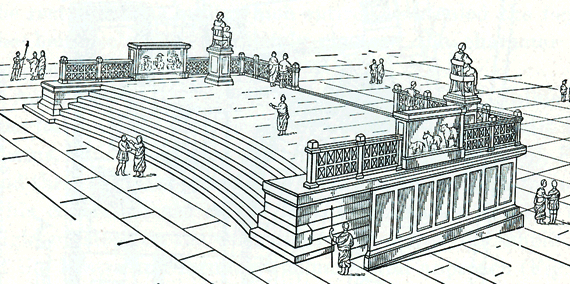
You find yourself standing on a high platform. There are many statues on the platform of imposing figures clad in togas. Arched above you are columns with more statues of famous Romans. This platform is called the Rostra because it is decorated on the front with the "beaks" (rostra) of ships. Originally, these beaks were taken from the ships captured in a battle off Antium in 338 BCE, and later replaced and supplemented by beaks from Carthaginian ships in 260 BCE. Eventually, the real beaks were also replaced by beaks made especially to be decorative features of this monument. The Rostra was the platform from which public speakers addressed the crowd and was the site of many important political orations, most notably by the great orator Cicero during the late Republic; behind the Rostra you will find an old capsa containing scrolls about Cicero. The Rostra was an extremely important public location and was often used as a short-hand symbol of political authority, as in this coin of 18 BCE, showing Augustus and Agrippa seated on the Rostra (more information on the Rostra).
This drawing of the Forum as it appeared in 300 CE will help you get your bearings. If you look to your left you see the Curia, standing imposingly on the northern border of the Forum. Next to it on the Sacra Via is the Basilica Aemilia. Directly ahead, you see the panorama of the Forum Romanum; across the Forum you see the Temple of Julius Caesar. Just off the front of the Rostra is a statue of Hercules, unusual because he is dressed in a tunic. In the distance you can see the Temple of Vesta, the houses topping the Palatine Hill, and the Temple of Castor. To your right stands the Basilica Julia. Just off the right side of the Rostra is the Arch of Tiberius, and behind it the Temple of Saturn.
As you entered this area, you might have noticed that you were greeted by a talking crow; click on Corvus to learn more about him.